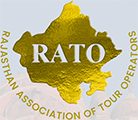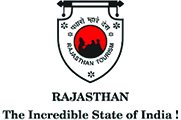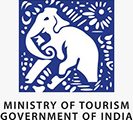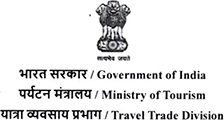Rajasthan Trip For 7 Days
A 7-day trip to Rajasthan is a colourful, royal and cultural experience. The trip explores major places like Jaipur, Ajmer-Pushkar, Jodhpur, Udaipur and Ranakpur, which showcase the diversity and rich heritage of this state. Jaipur, called the “Pink City”, is famous for its grand havelis, forts and bazaars. Its architecture and history leave tourists spellbound.
Ajmer and Pushkar are religiously and culturally important. The dargah of Khwaja Muinuddin Chishti in Ajmer attracts millions of devotees, while Pushkar is known for its Brahma temple and holy lake.
Jodhpur, the “Blue City”, is famous for its historic Mehrangarh Fort and narrow blue lanes. The city’s energy and vibrant Rajasthani culture are evident here. The Jain temple of Ranakpur offers a unique experience for its amazing marble carvings and serenity.
Udaipur, the “Lake City”, is a beautiful ending point to this trip. The lakes, palaces and romantic atmosphere of this place fascinate every traveler. Overall, this 7 day trip to Rajasthan becomes an experience that is remembered for a lifetime.
Rajasthan Itinerary Plan For 7 Days
Our Rajasthan trip plan for 7 days is designed to give you a perfect mix of culture, history, and adventure, allowing you to experience the essence of Rajasthan in a short span. Whether you’re fascinated by palaces, forts, or desert safaris, this trip covers it all, leaving you with unforgettable memories and a deep connection to this beautiful region.
Cities You Can Visit with Rajasthan Trip Plan for 7 Days
- Jaipur
- Ajmer
- Pushkar
- Jodhpur
- Ranakpur
- Udaipur
- Jaipur
Upon arrival at the airport or railway station, you will be warmly welcomed and greeted by our friendly representative. They will assist you with a smooth transfer to your hotel for check-in, ensuring you start your journey comfortably. This marks the beginning of your exciting Rajasthan trip plan for 7 days, where you’ll explore the vibrant culture, majestic forts, and rich traditions of the region. Get ready for an unforgettable adventure through the heart of Rajasthan!
After breakfast, we will visit Amber Fort, located about 12 km from Jaipur. It was the ancient capital of the Kachhwaha Rajput rulers. This unique wonder is a must-see on any tourist itinerary in Rajasthan. Construction of the fort and palace began in 1592 by Maharaja Man Singh, Akbar’s Rajput general. The Jai Singh family later expanded it before shifting their capital to Jaipur.
The fort is a magnificent example of Rajput architecture, situated on a magnificent hillside overlooking a lake. You will truly enjoy ascending the palace on the back of a gilded elephant. We will visit the numerous rooms and corridors of the palace, which are famous for their design and decoration.
In the afternoon, we will go on a tour of the iconic buildings of the city. First up is Jantar Mantar, a magnificent stone observatory built by Raja Jai Singh in 1728, known for his passion for astronomy. The Jaipur Observatory is the largest and best preserved of the five he built, the other four being in Delhi, Varanasi, Ujjain and Muthura.
We then visit the magnificent City Palace, a former royal residence built in a blend of Rajasthani and Mughal styles. The palace houses excellent museums displaying an outstanding collection of miniatures, traditional costumes and an armoury.
Later, we drive past the intriguing Hawa Mahal (Palace of Winds), one of Jaipur’s main landmarks. Built in 1799, this five-story structure is a magnificent example of Rajput art. It was originally built to allow the women of the royal family to observe the daily life and parades of the city.
After breakfast, we first drive down to Pushkar and stop at AJMER, located just 11 km from the town of Pushkar.
Ajmer, a rapidly growing town on the banks of the Ana Sagar River, has always been a town of military and historical importance, right from the time of Muhammad of Ghori who sacked it at least once during his regular and plundering expeditions from Afghanistan. Much later, and from the time of the Mughal Emperor Humayun, it became a favorite resort of the mighty Mughals.
It must be noted that one of the first Mughal-British contacts took place in Ajmer when Sir Thomas Roe, the English ambassador, met Emperor Jehangir there in 1616.
Today, Ajmer is a world-famous pilgrimage site for Muslims (as well as people of other faiths) who visit the sacred shrine of the Sufi saint Moinuddin Chisti, who came to Ajmer from Persia in 1192 AD. He is also popularly known as “Hazrat Khwaja Garib-e-Nawaz”, abbreviated as “HKGN”, which is often found inscribed on Muslim-owned trucks.
This “dargah” (=tomb) has the distinction of being the most visited Muslim shrine in the entire world and it is recorded that the mighty Emperor Akbar made a pilgrimage to this place every year, during the annual “Urs” held to mark the saint’s birthday.
PUSHKAR:
Pushkar, a charming little town, stands on the edge of the desert and is separated from Ajmer by the “Nag Pahar” or “Snake Mountain”.
This town is perhaps best known for its annual camel fair, a huge gathering of camels, cattle and livestock that takes place on the full moon night of the “Karthik” month of the Hindu calendar.
Another special feature of this town is the “Brahma Temple”, said to be one of the few temples in the world dedicated to “Brahma”, the creator and Lord of the universe. It is marked by a red tower and over the entrance gate is “his” (=swan, symbol of Brahma), who is said to have personally chosen Pushkar as the place and location.
After breakfast, we drive down to Jodhpur and upon arrival, we check into the hotel. Later, we go on a sightseeing tour of Jodhpur, which is the second largest city in Rajasthan. It is also known as the “Blue City” of India. It was the traditional capital of the larger kingdom of Marwar and specifically the kingdom of Jodhpur. It was founded by Rao Jodha in 1459. Jodhpur is located near the geographical center of Rajasthan and this makes it a central and convenient base for travel to other major tourist destinations like Udaipur, Jaisalmer, Bikaner and Jaipur.
We start our tour by visiting the Mehrangarh Fort which built the grand and majestic Mehrangarh Fort, which covers an area of almost 2000 acres. This structure is built of red sandstone and has intricately decorated large carved panels and lattices with unique designs. (Although the original fort was built in the mid-15th century, most of the existing structures date back to the 17th century.)
The present-day city of Jodhpur is largely built around the Mehrangarh Fort, which is surrounded by a fortified wall with several gates. The town offers several other popular tourist attractions, including many smaller forts, palaces, and temples, all set in the rugged landscape of the Thar Desert.
Another very interesting place to visit is the “Jaswant Thada”, a very impressive marble monument built in 1899 by Maharaja Sardar Singh in memory of his father, Maharaja Jaswant Singh II. This monument features carved pavilions and a terraced garden built around a small lake. The area around this monument also serves as a cremation ground for members of the royal family and rulers of Marwar. There is also a very interesting exhibition hall of the rulers and Maharajas of Jodhpur.
We also get to see the iconic “Clock Tower”, a landmark, as it was the only way for the locals to keep track of time in the past. You can get a magnificent view of the city from the top of this tower.
After breakfast, we continue our journey towards Udaipur, which is located about 250 km south of Jodhpur. The day’s itinerary is divided into two parts. The first part is a visit to Ranakpur and the second part is a visit and stopover in our destination for the night, the magical city of Udaipur.
The exceptionally beautiful Ranakpur complex, 60 km north of Udaipur, is one of the largest and most important Jain temples in all of India. It is located in a secluded valley in the Aravalli mountain range and is definitely worth a visit.
The main temple is the “Chaumukha” or “four-faced” temple, dedicated to Adinath, one of the 24 “Thirtankaras”, in the lineage of past spiritual masters and teachers who laid the foundation of the philosophy of the Jain religion.
This huge, magnificently constructed and well-maintained marble temple was built in 1439 AD. and has 29 halls supported by 1444 pillars, each unique in design and execution and no two pillars look alike! There are two other Jain temples within the complex, in addition to the “Sun Temple” and, not far away, the “Amba Mata Temple”.
After lunch, we head to Udaipur and upon arrival, we check into the hotel. In the evening, you will take a boat ride on Lake Pichola, an integral part of the landscape of the city of Udaipur. To the north of the lake and along the eastern bank, you can see the interesting “ghats” (=banks of water or river) used for bathing or washing (=“dhobi”-ghat; “dhobi” = washerman). Throughout the journey, we will see magnificent views of the glittering City Palace and the surrounding area on the horizon.
After breakfast at the hotel, we start our day with a visit to the famous and iconic City Palace, the most visited site in all of Udaipur. It is located on the eastern bank of Lake Pichola.
This truly beautiful and magnificent palace is also the largest palace complex in the entire state of Rajasthan and its construction was started by Maharaja Udai Singh II, the founder of the city of Udaipur (around 1568 AD).
The palace is actually a collection of buildings (as well as other minor palaces and luxurious palaces, which were added by rulers over the next 300 years), but still manages to maintain a remarkable uniformity in design. The palace has ornate balconies, towers and domes, and there are beautiful views of the lake and the city from the upper balcony.
The main part of the palace is now preserved as a museum housing a magnificent collection of mosaics, glass and mirrors, ornamental tiles, rare miniatures, fine sculptures, as well as an armoury displaying an interesting array of ancient weapons and fighting equipment of the brave Rajput warriors.
Another unique and fascinating feature of this city is the “Lake Palace Hotel”, which is situated on Jagniwas Island on Lake Pichola. This remarkable building, of sheer magical construction, literally appears to float in the middle of the lake. Built by Maharaja Jagat Singh II in 1754 AD, it previously served as the summer palace of the royal family of Udaipur. It was later converted into a luxurious holiday home and resort and is now considered one of the most luxurious hotels in the world.
In addition to the main attraction above, we will also discover two other interesting places:
Saheliyon-ki-Bari, or the “Garden of Maidens”, located in the northern part of the city. This small and pleasant ornamental garden has fountains, pavilions, marble elephants and a lovely lotus pond.
The Jagadish Temple, located just 150 meters north of the City Palace, is a fine example of Indo-Aryan architectural style. It was built by Maharaja Jagat Singh in 1651 AD. It houses a black stone idol of Vishnu, as “Jagannath”, the Lord of the Universe.
Traditional folklore says that the famous Mewar rulers are descended from what is believed to be the oldest ruling dynasty in the world, spanning over 76 generations..!!
A leisurely walk has been organised late in the evening around Lake Pichola to enjoy the enchanting charm and magical atmosphere of this beautiful city.
After breakfast, we proceed to Jaipur. After the visit, we depart and arrive at Jaipur Airport/Railway Station to catch the flight home.
We thank you very much for availing our services and hope that you have been satisfied with our commitment to provide you, our valued guests, with the best possible care and attention.
We would like to believe that this visit was a wonderful vacation and we are sure that you will recall precious memories that you will cherish for a lifetime.
Need Help ?? Contact us..!!
Mail Us
info@rajasthantourismbureau.com
Call Us
+91-9928026027 / +91-141-6783026
For details or any other query please contact below :
How It Works
- Choose from our curated tour packages designed around diverse interests and destinations, or create a custom travel itinerary for a journey that's uniquely yours.
- Once we receive your email, you can expect a prompt response within 24 hours, complete with a detailed itinerary tailored to your preferences and needs.
- Enjoy the convenience of secure online payment, or choose to pay upon arrival—whichever option best fits your preferences and travel plans.
- 5000+ Completed Tours with happy Clients
- 25+ Years of experience
- Globally Recognized As best Tour Operator





